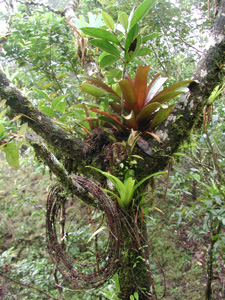Resource Library
Plant of the Week: Epiphytes bromeliads
The University of Arkansas System Division of Agriculture does not promote, support or recommend plants featured in "Plant of the Week." Please consult your local Extension office for plants suitable for your region.
Plant of the Week
Epiphytes Bromeliads

To grow, plants need a suitable temperature, carbon dioxide, water, nutrients and sunlight. Keen competition exists between plants of the same species and between species for these finite resources. Over time all manner of strategies have been used to outwit the competitors and get the upper hand. Epiphytes, also called air plants, are a diverse group of plants that have forsaken the nutrient rich soil and use other plants for support so they can get the light they need.
The word epiphyte literally means “upon plants” and refers to plants that use a second plant as a perch for physical support. Epiphytes do not derive nutrients from the supporting plant - usually a tree but sometimes power poles, fences or buildings will work too - and should not be confused with parasites such as mistletoe which actually absorbs carbohydrates directly from the host plant. Vines don’t count because they root into the soil. While mosses and lichens are technically epiphytes of the temperate world, most epiphytes are found in the tropics.
About 30,000 species of epiphytes have been described in a host of plant families with ferns and more primitive plants making up about 11percent of this total. The remaining 89 percent are flowering plants with orchids, bromeliads, tropical cacti, gesneriads (the African violet family) and peperomias are common examples. By growing high in the canopy of tropical forests epiphytes have solved the problem of low light but created new challenges - namely getting nutrients and conserving water.
Water is the most pressing issue concerning immediate plant survival. The tropics, though generally more moist than temperate regions, often experience periods of drought so epiphytes have used several strategies of surviving between rainy seasons. Succulence, or the development of specialized storage organs, is a common strategy. Christmas cactus, orchid cactus, many epiphytic gesneriads and peperomias have succulent stems or leaves that see them through dry periods.
Resurrection fern, a common fern found on tree trunks in the southern half of Arkansas, shrivels up and appears to be dead but quickly revives when moisture returns.
Orchids such as catleyas or oncidiums have developed swollen stem bases called pseudobulbs that swell during periods of abundant moisture and shrivel during dry spells. Most epiphytic orchids also have large stringy roots that affix the plant to the tree trunk but also aid in absorbing water directly from humid air. These soda-straw size aerial roots are silver-grey in color due to a coating of valamen which consists of spongy, dead cells that efficiently pull water directly from the air when the relative humidity is above 50 percent.
Bromeliads often employ a whorl of leaves arranged like a living funnel that catches and stores water in their so-called tank. This water not only gets the plants through periods of drought but provides habitat for a miniature ecosystem that includes a complex array of codependent organisms. As these organisms go about their short, but busy, lives in the bromeliad tank, their passing or excrements provide the nutrition the bromeliad needs. Spanish moss and other Tillandsia, also a bromeliad, employ scaly leaves that increase the surface area of the leaf and harvest moisture directly from the air.
Obtaining mineral nutrient seems to be the most daunting challenge for these plants suspended far above the soil but here too epiphytes have adapted. The world is a dusty place and dust accumulates on the leaves of tropical plants just as readily as it does on your newly washed car. When dust accumulates on the tree leaves of the supporting tree, some of it will be washed down the trunk in the furrows of the bark where the epiphytes have root attachments holding the plant in place.
Most orchids have mycorrhizal fungi attached to their roots that aid the plant in absorbing nutrients in exchange for some of the plant’s carbohydrate production. Additionally, most epiphytes grow in such a way that they trap falling leaves from the tree where they reside. These leaves, combined with a little dust and composting bacteria, provide rich organic compost that can accumulate sufficient weight to cause limbs to come toppling down.
Growing epiphytes such as orchids and bromeliads requires using a porous potting matrix and understanding these plants’ unique cultural requirements. Some of the most beautiful plants grown in horticulture are epiphytes but growing them successfully means tailoring growing conditions to suite the specific needs of the species.
By: Gerald Klingaman, retired
Retired Extension Horticulturist - Ornamentals
Extension News - March 25, 2011
The University of Arkansas System Division of Agriculture does not maintain lists of retail outlets where these plants can be purchased. Please check your local nursery or other retail outlets to ask about the availability of these plants for your growing area.